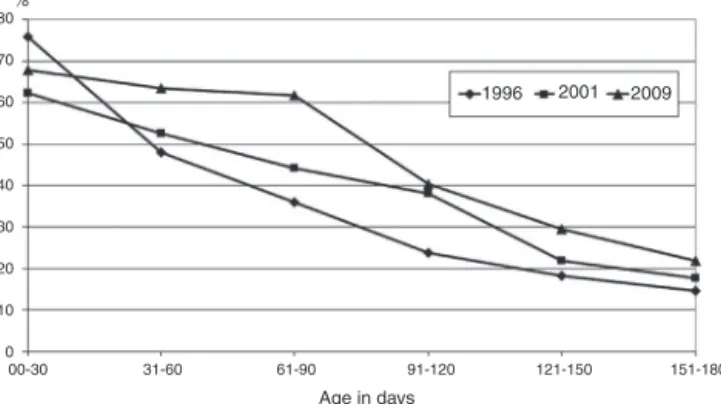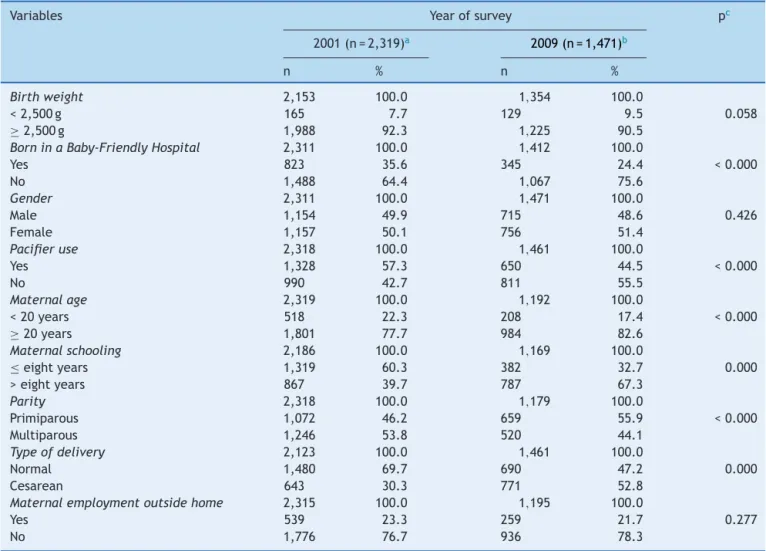JPediatr(RioJ).2015;91(3):270---277
www.jped.com.br
ORIGINAL
ARTICLE
Trends
in
breastfeeding
indicators
in
a
city
of
northeastern
Brazil
夽
Graciete
O.
Vieira
a,∗,
Mariana
R.
Reis
a,
Tatiana
O.
Vieira
a,
Nelson
F.
Oliveira
a,
Luciana
R.
Silva
b,
Elsa
R.J.
Giugliani
caUniversidadeEstadualdeFeiradeSantana(UEFS),FeiradeSantana,BA,Brazil
bUniversidadeFederaldaBahia(UFBA),Salvador,BA,Brazil
cUniversidadeFederaldoRioGrandedoSul(UFRGS),PortoAlegre,RS,Brazil
Received6May2014;accepted6August2014 Availableonline9February2015
KEYWORDS
Breastfeeding; Nutritionsurveys; Childnutrition; Cross-sectionalstudy; Healthstatus
indicators
Abstract
Objective: Toinvestigatetrendsinbreastfeedingindicators inthecity ofFeiradeSantana, Brazil,andtoidentifypopulationcharacteristicsthatmighthaveinfluencedthistrend.
Methods: Threemethodologicallycomparablecross-sectionalsurveysperformedin1996,2001, and2009wereanalyzed.Theseinvolved2,159,2,319,and1,471childrenyoungerthan1year ofagewhowerevaccinatedinnationalmultivaccinationcampaignsintherespectiveyears.A standardizedquestionnairewasused,containingclosedquestionsonconsumptionofbreastmilk andotherfoodsonthedaybeforethesurvey,alongwithquestionsregardingthecharacteristics ofthepopulation.
Results: Theannualgrowthofthebreastfeedingindicatorswas2.1%forbreastfeedinginthe firsthouroflife(from52.2%to68.9%);1.1%forbreastfeeding amongchildrenaged9to12 months(from45%to59.6%);and0.8%forexclusivebreastfeedingamonginfantsyoungerthan 6months (from36.9% to47.4%).The mediandurationofexclusive breastfeedingincreased from52.3to84.3days,andoverallbreastfeedingfrom278to376days.Somechangesinthe characteristicsof thepopulation were observed,which may have positively influenced the evolutionofthebreastfeedingindicators(betterschoolinglevelamongthemothers,lessuse ofdummies/pacifiers,andlowerproportions ofadolescentmothers),or negatively(greater proportionsofprimiparousmothersandcesareandeliveries,andlowerfrequencyofbirthsin Baby-FriendlyHospitals).
Conclusion: Thereweresignificantadvancesinbreastfeedingindicators,althoughtheyarestill farfromideal.Changesobservedinpopulationcharacteristicsmayhavepositivelyornegatively influencedthisevolution.
©2015SociedadeBrasileiradePediatria.PublishedbyElsevierEditoraLtda.Allrightsreserved.
夽 Pleasecitethisarticleas:VieiraGO,ReisMR,VieiraTO,OliveiraNF,SilvaLR,GiuglianiER.Trendsinbreastfeedingindicatorsinacity ofnortheasternBrazil.JPediatr(RioJ).2015;91:270---7.
∗Correspondingauthor.
E-mail:gracieteovieira@gmail.com(G.O.Vieira).
http://dx.doi.org/10.1016/j.jped.2014.08.012
PALAVRAS-CHAVE
Aleitamentomaterno; Inquéritos
nutricionais; Nutric¸ãodacrianc¸a; Estudostransversais; Indicadoresbásicos desaúde
TendênciadosindicadoresdealeitamentomaternoemumacidadedoNordeste brasileiro
Resumo
Objetivo: Verificar a tendência dos indicadores de aleitamento materno (AM) em Feira de Santana,Brasil, eidentificar características dapopulac¸ãoque possamter influenciadoessa tendência.
Métodos: Procedeu-se a análise de três inquéritos transversais, metodologicamente com-paráveis,realizadosem1996,2001e2009,envolvendo2.159,2.319e1.471menoresdeum anovacinadosnacampanhanacionaldemultivacinac¸ãodessesanos.Utilizou-sequestionário contendoquestõessobreoconsumo deleitematernoeoutrosalimentos nodia anteriorao inquérito,alémdeperguntassobrecaracterísticasdapopulac¸ão.
Resultados: OacréscimoanualnosindicadoresdeAMfoide2,1pontospercentuaisparaoAM naprimeirahoradevida(de52,2%para68,9%);1,1pontosparaoAMemcrianc¸asde9a12 meses(de45%para59,6%);ede0,8pontosparaoAMexclusivo(AME)emmenoresdeseismeses (de36,9%para47,4%).Adurac¸ãomedianadoAMEaumentoude52para84dias,eadeAMde 278para 376dias.Observou-se mudanc¸asnascaracterísticas dapopulac¸ão,asquais podem terinfluenciadoaevoluc¸ãodosindicadoresdoAMdeformapositiva(melhorescolaridadedas mães,decréscimonousodechupetaemenorprevalênciademãesadolescentes),ounegativa (maiorproporc¸ãodemãesprimíparasedecesarianas,emenorfrequênciadenascimentosem HospitalAmigodaCrianc¸a).
Conclusão: Houveavanc¸ossignificativosnosindicadoresdeAMemFeiradeSantana,embora aindaestejamlongedoideal.Mudanc¸asobservadasnascaracterísticasdapopulac¸ãopodemter influenciadopositivaounegativamenteessaevoluc¸ão.
©2015SociedadeBrasileiradePediatria.PublicadoporElsevierEditoraLtda.Todososdireitos reservados.
Introduction
Considering the impact of breastfeeding (BF) on child health, withsignificant impactoninfant mortalityrates,1 the promotion, protection and support of BF have been increasinglyprioritizedinpublichealthpolicies.
In Brazil, several measures have been implementedin thelast30years,includingtheBaby-FriendlyHospital Initia-tive(IniciativaHospitalAmigodaCrianc¸a---IHAC),Kangaroo Care;thecreationoftheBrazilianNetworkofHumanMilk Banks (Rede Brasileira de Bancos de Leite Humano---BLH); the national commemoration of the World BF Week; the Brazilian Breastfeeding and Feeding Strategy, focused on the encouragement ofbreastfeeding in primarycare; and recently,encouragingtheinstallationofbreastfeeding sup-port rooms in the workplaces of nursing women, among others.2
Asaresultofthesemeasures,significantadvanceshave been observed in BF indicators in the country. Exclusive breastfeeding (EBF), which was virtually non-existent in the1980s, waspracticedby 38.6%of mothers ofchildren youngerthan6monthsin2006,andtheBFmedianincreased from2.5monthsin1974to11.9monthsin2006.3Thetwo BFPrevalenceSurveys(PesquisasdePrevalênciade Aleita-mento Materno---PPAM) in Brazilian state capitals and the FederalDistrict,heldin1999and2008,2,4showedgreat vari-ability in BFindicators betweenthe capitals. In the2008 survey,themediandurationofEBFrangedfrom0.7days,in acapitaloftheMidwest,to89daysinaNortherncapital. The durationof BFrangedfrom293 daysinSãoPaulo, to
601daysin Macapá,in NorthBrazil.2,4 The comparisonof theresultsofthePPAMin1999and2008alsodemonstrated largevariationsintheindicators’evolutionindifferent cap-itals.Forinstance,inFortalezatherewasadecreaseinthe prevalenceofEBFinchildrenyoungerthan4monthsfrom 57%to41%andinCampoGrandetherewasanincreasein theprevalenceofthisindicatorfrom28%to62%.4
GiventhefactthatBFindicatorsandtheirevolutionvary significantlybetween Brazilian municipalities, it is impor-tantfor each locality toknow and monitor itsindicators, assessingtrends andfactorsassociated withthem. Demo-graphic characteristics are associated with the practice ofbreastfeeding,suchasage,education,parity,maternal employment,placeof birth,typeof delivery,andpacifier use,amongothers.ThedeterminantsofBFvaryin magni-tudeandeffectbetweendifferentpopulations.5,6
Feira de Santana, in the countryside of the state of Bahia, has been highlighted due to its BF indicators and itsworksupportingBF.Noteworthyinstitutionsincludethe city’simplementationof the firsthuman milkbank(HMB) inthestateandtheBreastfeedingIncentiveCenter(Centro deIncentivoemAleitamentoMaterno---CIAMA),referencesin thestateofBahia,inadditiontotwoIHAC-accredited hospi-tals,measuresthatallowedtheimplementationofactions topromotebreastfeeding.7InBahia,thereareonlysixHMBs andeightIHAC-accreditedhospitals.
272 VieiraGOetal.
thisstudysoughttoidentifypossiblechangesinpopulation characteristicsthatmayhaveinfluencedthistrend.
Methodology
DatafromthreeBF prevalence surveyswere used,whose methodological characteristics were similar, with cross-sectionaldesign,performedin1996,2001,and2009inFeira deSantana,alargecitywithapopulationof606,139 inha-bitantsin2013.8
A probabilisticsample of children younger than1 year wasobtainedineachofthestudies;thesechildrenattended thesecondphaseofthenationalmultivaccinationdayinthe respectiveyears,throughclustersamples,bydrawingofthe vaccinationunitsandproportionalprobabilitytothesizeof theclusters.Allchildrenyoungerthan1yearofage,livingin FeiradeSantana,whichattendedtheunitsthatweredrawn, wereincluded inthestudies.Thesampleestimates calcu-latedfor 1996, 2001, and2009 were,respectively, 1,663, 1,587and1,420children.Atotalof2,159childrenin1996, 2,319in2001,and1,471in2009participatedinthesurveys. Whilewaitingforthevaccination,adultcaregivers,after signing theinformed consent,were interviewedby previ-ouslytraineduniversitystudentsfromthehealtharea(40in 1996,104in2001,and166in2009).
Allthe surveys useda standardized questionnaire with closed questions on the consumption of breast milk and otherfoods,includingwater,teas,andothertypesofmilk, onthedaybeforethesurvey.This typeofsurvey(current status) isrecommendedbythe WorldHealthOrganization (WHO)9 toassessBF indicatorsat the population level.In the 1996 survey, the data collection tool was created by theauthorsinaccordancewithWHOrecommendations.In 2001and 2009, thetool wasbasedon theform prepared by the Ministry of Health, for the first and second PPAM, respectively.4Thedatacollectedin2009wereenteredinto awebapplication developed for thePPAM of theMinistry of Healthin the year 2008,4 and the datawere exported toSPSS (Inc. Released 2008. SPSS Statistics for Windows, Version17.0.Chicago,USA),thesamesoftwareusedinthe previoussurveys.
Inadditiontothenutritionsurvey,in2001and2009the followinginformationwereobtainedregardingthechildren: birthweight,gender,birthinaBabyFriendlyHospital (Hos-pitalAmigodaCrianc¸a---HAC),andpacifieruse;andmaternal age,education,workoutsidethehome,parity,andmodeof delivery.The1996surveydidnotprovidesuchdata.
The data allowed for evaluation of the following BF indicators: BF in the first hour of life; prevalence of EBF in children youngerthan 6 months;prevalence of breast-feedinginchildrenbetween9and12months,andmedian durationofBFandEBF.TheBFindicatorinthefirsthourof lifewasnotstudiedinthe1996survey.BFandEBFdefinitions adoptedbythesurveysarethesameasthoserecommended byWHO.10EBFwasconsideredaschildrenwhoreceivedonly breastmilk;andBFasinfantswhowerebreastfed, regard-lessofreceivingotherfoods.
Theproportionofchildrenyoungerthan1yearofagewho werebreastfedinthefirsthouroflife,ofchildrenyounger than 6 months who were EBF, and of children between 9 and 12 months whowere BF wasestimated. Then, the
00-30 80 % 70 60 50 40 30 20 10 0
31-60 61-90 91-120
Age in days
121-150 1996 2001 2009
151-180
Figure 1 Prevalence ofexclusive breastfeeding inchildren youngerthan6months.FeiradeSantana,Brazil,1996, 2001, and2009.
differencesweremeasuredregardingtheprevalenceofthe indicatorsfortheperiods1996-2001,2001-2009,and 1996-2009,andtheannualchangeinpercentagewascalculated. Pearson’schi-squaredtestwasusedtocomparedifferences in prevalence between the threesurveys, using a signifi-cancelevelof5%.TheestimatedmediandurationofBFand EBF wascalculated by logitanalysis, which estimates, by statisticalmodeling,theoddsoftheeventasafunctionof age.
Thecharacteristicsofchildrenandmothersofthe2001 and2009surveyswerecomparedusingPearson’schi-squared testandasignificancelevel<5%.
Each of the studies observed the legislation regarding human subjects (National Health Council Resolution 196/96),11 inaccordancewiththeDeclarationof Helsinki. Studiesperformedin1996,2001,and2009wereapproved, respectively, by the Ethics Committee of Hospital Geral CléristonAndrade(HGCA),bytheEthicsandResearch Com-mitteeofUniversidadeFederaldaBahia,andbytheEthics andResearchCommitteeofUniversidadeEstadualdeFeira deSantana(UEFS).
Results
Table 1 shows the BF indicators in each survey and their trendsoverthe13yearsbetweenthefirstandthirdsurveys. Significant improvements in all indicators were observed. BF in the first hour of life showed an annual increase of 2.1%(considering theeightyearsbetweenthesecond and third surveys). For BF in children from 9 to 12 months, the annual increase was 1.1%, and the EBF in children youngerthan 6months was0.8%, considering theinterval of13years.EBFprevalenceratesinchildrenyoungerthan 6monthsandBFinchildrenyoungerthan1year,inmonthly age intervals, from the surveys applied in 1996, 2001 and 2009in FeiradeSantana, areshown, respectively, in Figs.1and2.
The median duration of EBF increased from 52.3 days (95% CI: 44.8 to60.7) in 1996 to 84.3 days(95% CI: 73.7 to94.9)in2009,whereasBFincreasedfrom278days(95% CI264.1to292.3)to375.7days(95%CI:342.5to409.0)in thesameyears,bothstatisticallysignificant(Table1).
Trends
in
breastfeeding
indicators
in
a
city
of
northeastern
Brazil
273
Table1 Breastfeedingindicators.FeiradeSantana,Brazil,1996,2001,and2009.
Indicators Year Period
1996 2001 2009 1996-2001(5years) 2001-2009(8years) 1996-2009(13years)
Difference inperiod
Annual difference
p Difference
inperiod
Annual difference
p Difference
inperiod
Annual difference
p
Prevalence(%)of breastfeedinginthe1st houroflife
a 52.2 68.9 a a a 16.7 2.1 <0.000 a a a
Prevalence(%)of exclusive
breastfeeding<6months
36.9 39.0 47.4 2.1 0.4 >0.05 8.4 1.1 <0.000 10.5 0.8 <0.000
Prevalence(%)of breastfeeding9-12 months
45.0 51.8 59.6 6.8 1.4 <0.05 7.8 1.0 <0.015 14.6 1.1 <0.000
Mediandurationof breastfeeding,indays
278.0 302.4 375.8 24.4 4.9 >0.05 73.4 9.2 <0.05 97.8 7.5 <0.05
Mediandurationof exclusivebreastfeeding indays
52.3 57.0 84.3 4.7 0.9 >0.05 27.3 3.4 <0.05 32.0 2.5 <0.05
274 VieiraGOetal.
Table2 Descriptionandcomparisonofmaternalcharacteristicsandofchildrenyoungerthan1year.FeiradeSantana,Brazil, 2001and2009.
Variables Yearofsurvey pc
2001(n=2,319)a 2009(n=1,471)b
n % n %
Birthweight 2,153 100.0 1,354 100.0
<2,500g 165 7.7 129 9.5 0.058
≥2,500g 1,988 92.3 1,225 90.5
BorninaBaby-FriendlyHospital 2,311 100.0 1,412 100.0
Yes 823 35.6 345 24.4 <0.000
No 1,488 64.4 1,067 75.6
Gender 2,311 100.0 1,471 100.0
Male 1,154 49.9 715 48.6 0.426
Female 1,157 50.1 756 51.4
Pacifieruse 2,318 100.0 1,461 100.0
Yes 1,328 57.3 650 44.5 <0.000
No 990 42.7 811 55.5
Maternalage 2,319 100.0 1,192 100.0
<20years 518 22.3 208 17.4 <0.000
≥20years 1,801 77.7 984 82.6
Maternalschooling 2,186 100.0 1,169 100.0
≤eightyears 1,319 60.3 382 32.7 0.000
>eightyears 867 39.7 787 67.3
Parity 2,318 100.0 1,179 100.0
Primiparous 1,072 46.2 659 55.9 <0.000
Multiparous 1,246 53.8 520 44.1
Typeofdelivery 2,123 100.0 1,461 100.0
Normal 1,480 69.7 690 47.2 0.000
Cesarean 643 30.3 771 52.8
Maternalemploymentoutsidehome 2,315 100.0 1,195 100.0
Yes 539 23.3 259 21.7 0.277
No 1,776 76.7 936 78.3
aIn2001:Answernotknown/doesnotremember:consideredaslostdata.
b In2009:Answernotknown/doesnotremember:consideredaslostdata.Variablesrelatedtomotherswereonlycollectedininterviews
withthem.
c Comparisonofcharacteristicsofthesamplein2001and2009.Pearson’schi-squaredtest.
ofmothersaged20orolder(+4.9%)andhighereducation (+27.6%),primiparous (+9.7%)andcesarean deliveries(+ 22.5%);andlowerfrequencyofbirthsinHAC(-11.2%)and pacifieruse(-12.8%).
00-30
80 90 100
%
70
60
50
40
30
31-60 61-90 91-120
Age in days
121-150
1996 2001 2009
151-180 181-210 211-240 241-270 271-300 301-330 331-364
Figure 2 Prevalence of breastfeeding in children younger than1year.FeiradeSantana,Brazil,1996,2001,and2009.
Discussion
ThetrendsofBFinthecityduringthe13yearsshowed sig-nificantimprovementinthemediandurationofEBFandBF, andEBFprevalenceinchildrenyoungerthan6monthsandBF inchildrenfrom9to12months,inadditiontotheincreased prevalenceofBFinthefirsthouroflifeovereightyears.
Comparing the2009 surveyresults withthe II PPAM in 2008,4itcanbeobservedthattheBFindicatorinthefirst houroflifeinFeiradeSantana(68.9%)wassimilartothat found for the group of Brazilian capitals (67.7%) and the Northeastregion(66.9%),buthigherthanthatfoundin Sal-vador(58.5%),thecapitalofBahia.Accordingtoparameters adoptedbyWHO,12thisindicatorinFeiradeSantanacanbe classifiedasgood.
possibletocalculate,assuggestedbytheWHO,the propor-tionofchildren between12 and15.9months,considering theinvestigationincludedonlychildrenyoungerthan1year. ThesituationofFeiradeSantanaregardingthedurationof breastfeedingisconsideredpoor(376days)accordingtothe WHOcriteria,12althoughitisbetterthanthatofallthestate capitals(342days).
FeiradeSantanashowsanadvantageontheEBFindicator inchildrenyoungerthan6months(47.4%)whencompared withSalvador(36.5%),theNortheast(37.0%),andallofthe Braziliancapitals(41%).4Nevertheless,thissituationisonly consideredreasonablebytheWHO(between12%and49%).12 The mediandurationof EBFinFeiradeSantana(84days) exceedsby50daysthatoftheNortheast(34days),andby amonththatoftheBraziliancapitals(54days).This infor-mationisrelevant,asitisknownthatEBFprotectsagainst diseasesandinfantdeaths.1
As for the evolution of BF indicators in Feira de San-tana,therewasconsiderableprogressinall,particularlyin theproportionofchildrenbreastfedinthefirsthouroflife (increase of16.7% in eightyears),an average increaseof approximately2%peryear.Thisannualincreaseistwo-fold higherthanthatfoundforBrazil.Thenationaldemographic researchinhealthin199613and200614 showedanincrease of10.2%(from32.8%to43.0%)in10years,orroughly1%per year.However,accordingtothesameresearch,theincrease observedinthisstudywaslowerthanthatobservedforthe Northeast(4.4%peryear),increasingfrom7.3%in1996to 51.4%in2006.Arecentmeta-analysisfoundthattheBFin thefirsthouroflifeisassociatedwithareductionof44%to 45%ofneonataldeathsfromallcausesandfrominfection.15 ItispossiblethattheincreaseinthisindicatorinFeirade Santanais one ofthe factorsthat hascontributed tothis municipalitydemonstratingthehighestdecreasein neona-talmortalityrateinthestateofBahia,from27.8/1,000live birthsin2006to11.3/1,000in2012.16
The evolutionoftheBFcontinuityindicator,BFin chil-drenaged9-12months(increaseof14.6%in13years),was slightlylowerthantheevolutionofthisindicatorinallthe statecapitals-1.1%peryearinFeiradeSantanaversus1.8% peryearinthecapitals.Thiscanbeexplainedbythefact that the city is in a betterposition regarding this indica-torinpreviousresearches;theprevalenceofBFinchildren aged9-12 monthsin Feirade Santanain 1996 washigher than that in all the capitals in 19992 (45% versus 42.4%). ComparisonoftheresultsofthetwoPPAMsintheBrazilian capitals,conductedin1999and2008,clearlyshowedthat therewasa greater increasein BFindicators in the capi-talswithworseconditionsin1999and,ontheotherhand, morediscreetadvancesorevenregressioninplaceswhere conditionsweremorefavorable.2
Although Feira de Santana shows a privileged position regarding the EBF indicator in children younger than 6 months,thiswastheindicatorthatshowedleast develop-ment (increaseof 10.5% in 13years), withan increaseof 0.8%peryear.ThefactthatFeiradeSantanahad,in1996, aprevalenceofEBFinchildrenyoungerthan6monthsthat washigherthantheaveragefoundintheBraziliancapitals in1999(36.9%versus26.7%),3mayexplain,atleastinpart, thisresult.
TounderstandthetemporalchangesofBFindicators,itis necessarytoconsiderthefactorsthatmayhaveinfluenced
thesechangesinthecity,becausehealth indicatortrends shouldbe interpreted according toindividual,social, and culturaldeterminantsandpublichealthpolicies.The devel-opmentinBFindicatorsinBrazilhasbeensupportedbythe NationalPolicyfortheProtection,Support,andPromotion ofBreastfeeding.2,17
The implementation of various strategies of this pol-icy in Feira de Santana may have contributed to the improvementofthe BFindicators.The implementationof CIAMA/BLH(ReferenceCentreforthePromotionof Breast-feeding/HumanMilkBank),1987,thecreationofthesecond BLH,1992,and theaccreditationof twohospitalsin IHAC in the mid-1990s started the increasing care for nursing mothers and training of human resources. In CIAMA/BLH, atotalof9,141,27,118,and80,691womenweretreated, respectively, in theperiods of 1987-1995, 1996-2000, and 2001-2008.Duringthesameperiods,atotalof143,1,079, and 161 middle-level health care workers and 184, 146, and 225 upper-level health care workers were trained in breastfeedingmanagement,inadditiontomobilization dur-ingWorldBFWeeks.
ThepartnershipbetweentheBLHs,Universities,andthe MunicipalHealthSecretariatallowedtwelveBFeventstobe heldforcollegestudentsandhealthprofessionalsandfive ‘‘BFMeetings’’,aimedat children andadolescentsin the municipalschools.Thereisnoassessmentoftheimpactof theseactionsalone,butitisbelievedthatalltheseactions contributedtotheimprovementofBFindicatorsinFeirade Santana.Astudy involving111 municipalitiesof SãoPaulo founda2.4-higherchance ofEBFinchildrenyoungerthan 6months when themunicipality hadfour or more pro-BF actions.18
Inadditiontopublicinvestmentsfortheprotection, sup-port,andpromotionofbreastfeedinginFeiradeSantana,it ispossiblethatchangesofsomepopulationcharacteristics haveinfluencedtheBFindicators.Comparingmaternaland children’svariablesinthelasttwosurveys,itwasobserved thatsomechangesmaybefavoringorhinderingthe devel-opmentofBFindicators.Among thematernalfactorsthat maybecontributingpositivelyarethelowerproportionof adolescentmothersandhighereducationallevel.Although thereis noconsensusontheassociation betweenyounger maternal age and lower rates of BF, studies have shown this association in Brazil.4,19 Similarly, most studies have reported a positive association between higher maternal educationallevel and durationof BF, especially EBF, with adose-responseeffect.4,6,18,20
276 VieiraGOetal.
wishtoinitiatebreastfeeding,theyusuallypracticeit for lesstime.23,24 Regarding thetypeofdelivery,studieshave foundalowerprevalenceofBF24,25 andEBF6,23,25inwomen undergoingsurgicaldeliveries.FeiradeSantanafollowsthe nationaltrendofincreasingprevalenceofcesareandelivery inBrazil.26
Inadditiontothealreadymentionedindividualfactors, thedecreaseofbirthsinHACmayhavenegativelyinfluenced theevolutionofBFindicators, asthepositiveinfluenceof IHAContheprevalenceofBFhasbeenwelldocumented.27,28 Themainmethodologicallimitationsofthisstudyaredue toitsdesign,whichdoesnotestablishaperfectcausal asso-ciation between the change in population characteristics andtheevolutionofBF, asitwasacross-sectionalsurvey. Additionally, some sociodemographic characteristics were notstudied,such asfamilyincome, prenatalinformation, andpaternalvariables,amongothers;6andtheabsenceof informationontheBFindicatorinthefirsthouroflifeand populationcharacteristicsinthe1996survey.However,the methodologicalapproachisfeasibleandreplicable,29 allow-ingmonitoringofBFindicatorsovertime,whichisimportant fortheplanningofactionsatthelocallevel.
In conclusion, this study found a growing trend of the mainBFindicatorsinFeiradeSantanaandadditional knowl-edge related to changing population characteristics that mayhavepositivelyor negativelyinfluencedtheobserved trends. However,as observed in other parts of the coun-try,theseindicatorsarestillfarfrombeingacceptablefor theWHO, indicating the need toincrease the practiceof breastfeedinginthecountry.
Funding
Fundac¸ãodeAmparoàPesquisadoEstadodaBahia(FAPESB). GrantTerm73/04.
Conflicts
of
interest
Theauthorsdeclarenoconflictsofinterest.
References
1.JonesG,SteketeeRW,BlackRE,BhuttaZA,MorrisSS.Howmany childdeathscanwepreventthisyear?Lancet.2003;362:65---71. 2.VenancioSI,EscuderMM,SaldivaSR,GiuglianiER.Apráticado aleitamentomaternonascapitaisbrasileiraseDistritoFederal: situac¸ãoatualeavanc¸os.JPediatr(RioJ).2010;86:317---24. 3.VenancioSI,SaldivaSR,MonteiroCA.Seculartrendsin
breast-feedinginBrazil.RevSaudePublica.2013;47:1205---8. 4.Brasil.,Ministérioda,Saúde.,SecretariadeAtenc¸ãoà,Saúde.,
Departamento de Ac¸ões Programáticas e, Estratégicas., II., PesquisadePrevalênciadeAleitamentoMaternonasCapitais Brasileiras eDistrito Federal. 1st ed. Brasília: Ministério da Saúde;2009.p.108[cited01Dec2013].
5.RobertE,CoppietersY,SwennenB,DramaixM.Breastfeeding duration:asurvivalanalysis-datafromaregionalimmunization survey.BiomedResInt.2014:529790.
6.Boccolini CS.Determinantes sociaisdoaleitamentomaterno. [Thesis].RiodeJaneiro:Fundac¸ãoOswaldoCruz;2012. 7.VieiraGO,GlisserM,AraújoSP,SalesAN.Indicadoresdo
aleita-mentomaternonacidadedeFeiradeSantana,Bahia.JPediatr (RioJ).1998;74:11---6.
8.Brasil. Instituto Brasileiro de Geografia e Estatística- IBGE. Cidades-Bahia-FeiradeSantana.Brasília:IBGE;2014[cited 6Jul2014].
9.WorldHealthOrganization.Indicatorsforassessinginfantand youngchildfeedingpractices:conclusionsofaconsensus meet-ingheld6-8November2007inWashingtonD.C.USA.Geneva: WorldHealthOrganization;2008.
10.WorldHealthOrganization.Indicatorsforassessinginfantand youngchildfeedingpractices---partI:definition.Geneva:World HealthOrganization; 2010. Availablefrom:http://www.who. int/maternalchildadolescent/documents/9789241596664/en/ index.html[cited20Mar2013].
11.Brasil. Ministério da Saúde. Comissão Nacional de Ética em Pesquisa.In:Normasparapesquisaenvolvendosereshumanos (Res. CNS. 196/96 e outras). Brasília: Ministério da Saúde; 2000.
12.WorldHealth Organization.Infantandyoungchildfeeding: a toolforassessingnationalpractices,policiesandprogrammes. Geneva:WorldHealthOrganization;2003.
13.Sociedade Civil Bem-estar familiar no Brasil (BEMFAM) Amamentac¸ão e Situac¸ão Nutricional das Mães e Crianc¸as. PesquisaNacionalsobreDemografiaeSaúde.RiodeJaneiro. 1997:125---38.
14.Brasil. Ministério da Saúde Centro Brasileiro de Análise e
Planejamento.Pesquisa Nacional de Demografia e Saúde da
Crianc¸aedaMulher---PNDS2006:dimensõesdoprocesso
repro-dutivoeda saúde dacrianc¸a. Brasília:Ministério da Saúde;
2008.
15.Debes AK, Kohli A, WalkerN, Edmond K, Mullany LC.Time to initiation of breastfeeding and neonatal mortality and morbidity:a systematicreview. BMCPublicHealth.2013;13: S3---19.
16.Secretaria de Saúde da Bahia. [cited Jun 29 2014].
Avail-able from: http://webcache.googleusercontent.com/
search?q=cache:lnKv9yL3FuEJ:www.saude.ba.gov.br/dab/BA
MonitoramentoTx%2520MortalidadeNeonatal.xls+&cd=4&hl
=pt-BR&ct=clnk&gl=br&client=firefox-a)
17.Rea M. Reflexões sobre a amamentac¸ão no Brasil; de como passamos a 10 meses de durac¸ão. Cad Saude Publica. 2003;19:S37---45.
18.Venancio SI, Monteiro CA. Individual and contextual deter-minants of exclusive breast-feeding in São Paulo, Brazil: a multilevelanalysis.PublicHealthNutr.2006;9:40---6.
19.FrotaDA,MarcopitoLF.Amamentac¸ãoentremãesadolescentes enão-adolescentes, Montes Claros, MG. Rev Saude Publica. 2004;38:85---92.
20.CaminhaMdeF,BatistaFilhoM,ServaVB,ArrudaIK,Figueiroa JN,LiraPI.Timetrendsandfactorsassociatedwith breastfeed-inginthestateofPernambuco.NortheasternBrazilRevSaude Publica.2010;44:240---8.
21.ScottJA,BinnsCW,OddyWH,GrahamKI.Predictorsof breast-feeding duration: evidence from a cohort study. Pediatrics. 2006;117:e646---55.
22.JaafarSH,JahanfarS,AngolkarM,HoJJ.Effectofrestricted pacifier use in breastfeeding term infants for increasing duration of breastfeeding. Cochrane Database Syst Rev. 2012;7:CD007202.
23.FaleirosFT,TrezzaEM,CarandinaL.Factorsinfluencing breast-feedingdecisionandduration.RevNutr.2006;19:623---30.
24.ThulierD, MercerJ. Variablesassociated withbreastfeeding duration.JObstetGynecolNeonatNurs.2009;38:259---68.
26.VictoraCG,AquinoEM,CarmoLealM,MonteiroCA,BarrosFC, SzwarcwaldCL:.MaternalandchildhealthinBrazil:progress andchallenges.Lancet.2011;377:1863---76.
27.Venancio SI, Saldiva SR, Escuder MM, Giugliani ER. The Baby-Friendly Hospital Initiative shows positive effects on breastfeeding indicators in Brazil. J Epidemiol Community Health.2012;66:914---8.
28.SampaioPF,MoraesCL,ReichenheimME,OliveiraAS,Lobato G.Birth inBaby-Friendly HospitalsinRiode Janeiro,Brazil:
a protective factor for breastfeeding? Cad Saude Publica. 2011;27:1349---61.


